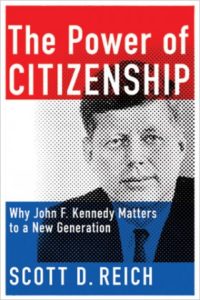The Power of Citizenship
The world loves to remember JFK. Schools and streets have been named for him; parks, buildings, and an airport bear his name. Children are named after him. He is quoted in speeches. His words rest on plaques and refrigerator magnets and bumper stickers. Images of his face adorn book covers, posters, and the walls of college dorm rooms, offices, and people’s homes. He is one of only a few figures in American history known simply by his initials—no further identifying factors are needed.
In Washington, D.C., millions of people have visited his grave set high on a hill at Arlington National Cemetery. Indeed, many children have had perhaps their first conscious interaction with Kennedy by visiting the grave and receiving an explanation of the importance of this man with the eternal flame over his final resting place. To hear such explanations offers a telling glimpse into the ways in which Kennedy endures. Some speak of his tragic death; others emphasize aspects of his life; and still others wonder, sometimes aloud, what things might have been like for the country and the world had he lived longer and served a second term.
Near the grave is a low memorial wall inscribed with quotations from the president’s historic inaugural address. Here, for all time, are words chiseled into granite to offer generations of visitors a chance to bear witness to the guiding principles of the Kennedy presidency. Seeing such beautiful prose on the wall—including lines such as “Let every nation know, whether it wishes us well or ill, that we shall pay any price, bear any burden, meet any hardship, support any friend, oppose any foe, to assure the survival and the success of liberty,” and “The energy, the faith, the devotion which we bring to this endeavor will light our country and all who serve it, and the glow from that fire can truly light the world”—makes one wonder: if, over the centuries, our whole civilization were to disappear but for that wall, would it alone tell future historians enough about who we were as a people?
A short drive from the cemetery is the performing arts center that bears his name, which honors the arts in ways commensurate with the manner in which Kennedy promoted them. Not far from the performing arts center is the White House, where the most famous portrait of Kennedy—the painting with the president looking downward over his folded arms—hangs prominently on the first floor.
And still, Kennedy is remembered in other ways. He is honored by the presidential library dedicated to his memory in Columbia Point, Boston. His birthplace in Brookline, Massachusetts, has been designated a national historic site. There is a museum in Dallas near the fateful place he was shot. Items that belonged to the president regularly fetch large sums at auctions (in February 2013, for instance, the president’s Air Force One bomber jacket was sold for $570,000). Films and television miniseries such as JFK, The Kennedys, The Missiles of October, Thirteen Days, and others have depicted his life, aspects of his time in office, and his assassination. New books are published about him every year. Teachers recite words that he spoke. His name enters the national discourse during every political convention and amidst coverage of almost any presidential election debate. The media hovers around Kennedy as subject matter on every five-year anniversary of his birth, death, historic election, and inauguration.
Year after year, we seem only to increase this longing, this devotion to learning more about Kennedy—we want to see him again; we want to understand him from a different angle; we want to be reminded of this time in our collective past. He is, undeniably, an American icon embedded deeply in our national consciousness. But why? Why this man?


